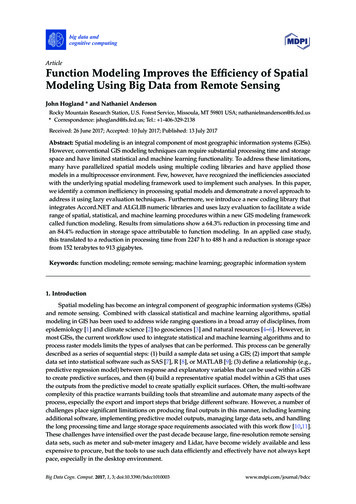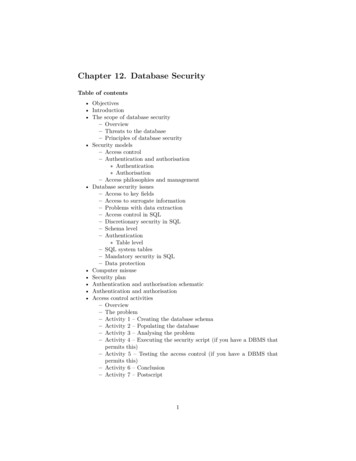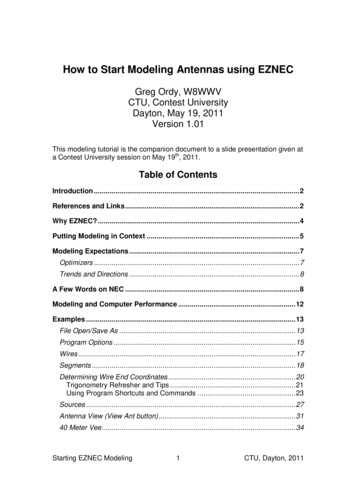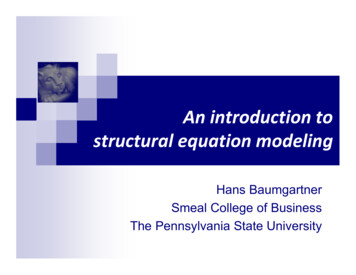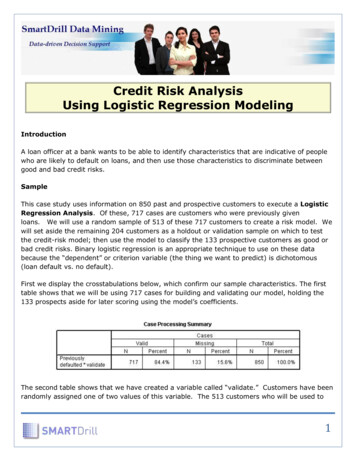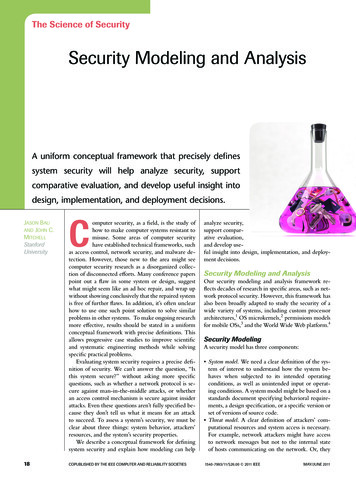
Transcription
The Science of SecuritySecurity Modeling and AnalysisA uniform conceptual framework that precisely definessystem security will help analyze security, supportcomparative evaluation, and develop useful insight intodesign, implementation, and deployment decisions.Jason Bauand John C.MitchellStanfordUniversity18Computer security, as a field, is the study ofhow to make computer systems resistant tomisuse. Some areas of computer securityhave established technical frameworks, suchas access control, network security, and malware detection. However, those new to the area might seecomputer security research as a disorganized collection of disconnected efforts. Many conference paperspoint out a flaw in some system or design, suggestwhat might seem like an ad hoc repair, and wrap upwithout showing conclusively that the repaired systemis free of further flaws. In addition, it’s often unclearhow to use one such point solution to solve similarproblems in other systems. To make ongoing researchmore effective, results should be stated in a uniformconceptual framework with precise definitions. Thisallows progressive case studies to improve scientificand systematic engineering methods while solvingspecific practical problems.Evaluating system security requires a precise definition of security. We can’t answer the question, “Isthis system secure?” without asking more specificquestions, such as whether a network protocol is secure against man-in-the-middle attacks, or whetheran access control mechanism is secure against insiderattacks. Even these questions aren’t fully specified because they don’t tell us what it means for an attackto succeed. To assess a system’s security, we must beclear about three things: system behavior, attackers’resources, and the system’s security properties.We describe a conceptual framework for definingsystem security and explain how modeling can helpanalyze security,support comparative evaluation,and develop useful insight into design, implementation, and deployment decisions.COPUBLISHED BY THE IEEE COMPUTER AND RELIABILITY SOCIETIES1540-7993/11/ 26.00 2011 IEEE Security Modeling and AnalysisOur security modeling and analysis framework reflects decades of research in specific areas, such as network protocol security. However, this framework hasalso been broadly adapted to study the security of awide variety of systems, including custom processorarchitectures,1 OS microkernels,2 permissions modelsfor mobile OSs,3 and the World Wide Web platform.4Security ModelingA security model has three components: System model. We need a clear definition of the system of interest to understand how the system behaves when subjected to its intended operatingconditions, as well as unintended input or operating conditions. A system model might be based on astandards document specifying behavioral requirements, a design specification, or a specific version orset of versions of source code. Threat model. A clear definition of attackers’ computational resources and system access is necessary.For example, network attackers might have accessto network messages but not to the internal stateof hosts communicating on the network. Or, theyMAY/JUNE 2011
The Science of Securitymight have unbounded storage but insufficientcomputational power to break cryptography. OS attackers might be able to place malicious code in auser process but unable to modify the OS kernel. Security properties. We must clearly define the properties that we hope to prevent attackers from violating.For each behavior, such as a sequence of inputs, outputs, and state changes, we must clearly determinewhether the desired security properties hold or fail.A security model is secure if the system designachieves the desired properties against the chosenthreat model. A system model might consist of a set oftraces (action sequences) or some other set of possiblebehaviors. Some traces might occur only throughactions intended by the system designers, and others might occur when attackers perform actions thataren’t expected. In some cases, the desired propertiesmight be trace properties—for every trace, the security properties either hold or fail. Such a system is secureif no trace that could arise as the result of intendedor attacker actions causes any of the desired securityproperties to fail. Thus, no definition of security existsapart from the security model. Unless we know howa system behaves, what attackers might do, and whichsecurity properties are intended, we can’t determinewhether the system is secure.Common security properties include confidentiality (no sensitive information is revealed), integrity (attackers can’t destroy the system’s meaningfully operable condition), and availability (the attacker can’trender the system unavailable to intended users).However, there’s no foundational understanding ofwhy these properties are considered security properties and others aren’t, and there’s no standard way todecompose a given property into confidentiality, integrity, and availability components. Therefore, in future research, we should clearly define different classesof security properties and their relationships.Security AnalysisSecurity models provide a basis for security analysis—the process of evaluating whether the systemdesign achieves the desired properties against the chosen threat model. It also lets us compare the relativestrengths of different system designs.Analysts use traditional methods such as manualinspection, team discussion, and mathematical proofto examine whether a design achieves its desired goals.Formal and automated methods can also aid humanreasoning and are often effective because of the complexity of many systems and the difficulty of ensuring that all details have been properly considered.Formal methods require an analysis conforming tospecific rules and procedures that often originate inmathematical logic, and automated methods providecomputer support for formal methods.Two automated methods are model checkers andautomated theorem provers. Model checking is abroad topic that includes tools that enumerate all possible executions of a finite-state system and symbolicmodel checkers. When a security model is formulatedor approximated as a finite-state system, these tools areeffective for finding security flaws. When abstractionmethods “collapse” an infinite-state system to a finitestate,5 a finite-state tool can also demonstrate securityby the absence of any sequence of attacker actions thatcauses the desired security properties to fail. However,model checkers are often insufficient in showing theabsence of successful attacks. In contrast, automatedtheorem provers can establish a model’s security bymathematically demonstrating that no combination ofattacker actions that the threat model allows can causethe desired properties to fail.6Evaluation. Security analysis evaluates models ac-cording to threats and intended security properties.Another important issue is whether these threats andproperties adequately reflect practical use. Email systems are an interesting example. Originally, the system’s purpose was to convey every email message toits specified address. Later, users discovered that thiswasn’t the complete specification for the desired system; now its recognized purpose is to carry wantedemail from a sender to a receiver and discard or setaside spam.Metrics. Although security models don’t intrinsicallyprovide a numeric security metric, we can comparethem by comparing the relative strengths of systemdefenses, threat models, and security properties. Forexample, we can develop qualitative comparisons byordering properties and threat models—systems satisfying a stronger security property will satisfy a weakerproperty in the same threat model, and systems satisfying a stronger threat model’s security propertywill satisfy that property in a weaker threat model.We hope that future research will develop simulationrelations between systems, so we can compare thestrength of two different systems for the same property against the same threat model. Once we establishcomparative techniques for varying the system, thethreat model, and the properties individually, we cancombine them to produce a multidimensional comparative security theory.We illustrate the security modeling and analysisprocess using model-checking examples from network protocol security, hardware security, and Websecurity; however, we only scratch the surface of thetopic with these examples.www.computer.org/security 19
The Science of Security{A, NonceA}Ke{A, NonceA}KbA{NonceA, NonceB }KaAB{NonceB }Kb(a){NonceA, NonceB }Ka{A, NonceA}KbE{NonceA, NonceB }KaB{NonceB }Ke(b)Figure 1. Needham-Schroeder protocol. (a) Legitimate parties A and B participate in the protocol by transmitting the messages indicatedby the arrows. (b) Attacker E can compromise the protocol by intercepting and retransmitting messages. It poses as party A from party B’sperspective and gains the secrets shared between A and B.Network Protocol Modelingand AnalysisNetwork protocols with security requirements arecritically important to Internet security. Some wellknown examples are the Secure Sockets Layer (SSL)protocol and its successor for Transport Layer Security(TLS); protocols for using wireless access points, suchas Wired Equivalency Privacy (WEP) and Wi-Fi Protected Access (WPA); and secure versions of networkinfrastructure protocols, such as Domain Name System (DNSSEC).Security modeling and analysis is a natural fit forstudying network protocol security because the protocols’ distributed nature makes manual reasoning about the full implications of multiparty participation difficult, and we can derive a protocol operation model directlyfrom the protocol standard, making analysis resultsdirectly relevant to the standardization process.Therefore, network protocol modeling might bethe most significant and successful example of the security modeling and analysis process. It has become arobust field, with publications every year at academicconferences. For instance, the 2010 IEEE ComputerSecurity Foundations Symposium program includedpublications using security modeling and analysis toverify the ad hoc mobile routing7 and RFID8 protocols’ security properties.Because it’s easily accessible, we describe some aspects of network protocol security modeling usingthe Needham-Schroeder (NS) public-key protocol(see Figure 1).9 Surprisingly, after its publication, ittook nearly 10 years of academic research on protocol security before Gavin Lowe found a subtle problem with the protocol while conducting securityanalysis.10 The problem isn’t an actual attack on aproperty that the designers claimed for their protocol, but the failure of a property that many protocolusers might expect. In addition, Lowe proposed a20IEEE SECURITY & PRIVACY very simple modification to the protocol that clearlyimproves its security.Modeling System BehaviorThe first step of security modeling is to describe theprotocol operations down to an appropriate detaillevel. The NS protocol uses public-key cryptographyto exchange private random numbers, NonceA and NonceB, between two parties, A and B, without revealing them to observers. Public-key cryptographyprovides party A with a public key, Ka , and a privatekey, Ka-1, and lets any other party use Ka to encrypt amessage M to A, denoted as {M }K a, with only A possessing the ability to decrypt it.This protocol has been modeled in many ways,including with formal languages10 and finite-stateenumerator languages such as Murphi.11,12 Here, wefocus on finite-state modeling. In the model, partiesA and B are represented as a set of states with a set ofstate action rules. The states denote both the protocol’s progress and the actual knowledge gained fromthe protocol, such as the nonce of the other party.For the NS protocol, each party stores its own nonceas well as a possible nonce from the network. Eachparty has three states: initial sleep, waiting for response,and committed.The set of action rules “perform” the next protocolstep on the basis of the current state and the validity ofinformation received from the network. Party A hastwo state-transition rules: sending message 1 and proceeding to the waitingfor-response state, and verifying message 2 as containing NonceA and, ifproperly verified, sending message 3 and changingto the committed state.Party B also has two rules: accepting message 1, sending message 2, and moving to the waiting-for-response state, andMAY/JUNE 2011
The Science of Security verifying message 3 as containing NonceB and, ifproperly verified, moving to the committed state.The network is modeled as shared states betweenthe parties, and thus each specific network message isrepresented as a particular network state setting.Modeling Threat BehaviorThe next aspect of security modeling is to explicitlydefine attackers’ capabilities and operations. In network protocol security, attackers are typically giventhe following abilities, commonly referred to as theDolev-Yao model and used in many studies (includingJohn Mitchell and his colleagues’ “Automated Analysis of Cryptographic Protocols Using Murphi”12): eavesdropping on any network message and breaking its content (as captured) into parts, recording parts of any eavesdropped packet intostorage, removing messages from the network, and sending network messages containing new or eavesdropped content to any legitimate party.The attackers’ knowledge, with which they mightforge network messages, is formalized as the union of aset of initial knowledge, such as public keys and participants’ names, and the data obtained from eavesdropping.Also, each attacker capability is distinctly represented asa rule reading or manipulating network state, similarto legitimate participants’ protocol steps. The ability torepresent each attacker action in a fine-grained mannerenables direct comparison of threat models.Modeling CryptographyBecause network protocols use cryptography, wemust include it in the model. One simple but surprisingly effective approach involves idealized cryptography. In a model with idealized cryptography, attackerscan’t compromise cryptographic protections, such asencryption and signatures, without the appropriatekey. In the NS model, attackers can only record andreplay the ciphertext form of encrypted data capturedfrom the network and can’t compromise the plaintextcontent. Attackers can also create ciphertext usingtheir own private key, assuming proper decryptioncan only be performed using the attackers’ identifyingpublic key.Modeling Security PropertiesThe third aspect of security modeling is to representthe security properties in the modeling framework.Security properties conveying integrity or confidentiality are typically expressed as invariants—logicalexpressions on the state of the model that must beguaranteed. For example, in the NS model, the integrity invariants specify that, for party A, reachingthe committed state means that the accepted secret isNonceB—and vice versa for party B. The NS model’ssecrecy invariant will specify that no attackers candecrypt and learn secrets from any intended parties,despite their expressed capabilities.Integrity and secrecy invariants are common inmany protocols’ security models. Availability or liveness, on the other hand, are often more difficult toexpress, especially in a finite-state model.Protocol Vulnerabilities and FixesFigure 1b illustrates the weakness uncovered using theautomated model-checking tools for the NS protocol. The tool finds a protocol-execution trace wherethe attacker E learns secrets meant to be kept betweenparties A and B by acting as a man in the middle.The discovery of this trace triggers violations of themodel’s secrecy and integrity invariants.Beyond simply finding vulnerabilities, securitymodeling and analysis can also verify fixes for thesevulnerabilities—we simply add the fixing protocolfeature to the model, then recheck against attackercapabilities to ensure that the previously violated security properties are now inviolate. For NS, the fix—which requires party B to send its identity encryptedin message 2, and party A to validate that identityagainst message 1’s intended recipient—was verifiedin the model as upholding the security invariants.Hardware Security Modelingand AnalysisResearchers have used security modeling and analysisto study hardware and software system security suchas the Execute Only Memory (XOM) processor architecture3 and Google Android’s permissions-basedsecurity.5 In addition, related verification techniques,such as formal verification of software against specification and model checking for bug finding (whichdiffer from our security modeling and analysis definition by the omission of a threat model), have beenfruitful academic fields, producing interesting resultssuch as the full verification of the seL4 OS micro kernel4 and the discovery of serious bugs in widelyused file systems.13In this example, we focus on the XOM processor’sarchitecture to further illustrate the security modeling and analysis framework’s adaptability. XOM is ageneric microprocessor architecture that maintainssecure memory compartments for programs while assuming attacker control over privileged code, such asOSs.3 XOM tries to guarantee that a user program’smemory integrity would be equivalent to making theprogram the only code executing on the machine. Towww.computer.org/security 21
The Science of SecurityTable 1. Modeled XOM instructions.User-level instructionsKernel-level iptionRegister useRead a registerRegister saveEncrypt a user register into another registerRegister defineWrite a registerRegister restoreDecrypt an encrypted user registerStoreStore register to memoryPrefetch cacheMove data from memory into cacheLoadLoad register from memoryWrite cacheOverwrite data in the cacheFlush cacheFlush cache line into memoryTrapInterrupt userReturn from trapReturn execution to userthis end, XOM provides a tamper-resistance propertythat guarantees other privileged programs, includingoperating systems, won’t read or manipulate user program data without detection.XOM Operational OverviewXOM creates a tamper-resistant memory hierarchy bytagging data at the processor, register, and cache levelsand encrypting data in the main memory.Each user program in an XOM machine has aunique key, called a compartment key, associated (one toone) with an XOM ID tag. The program is initiallyencrypted with the compartment key, and when thecode executes, it’s read from memory, decrypted, andtagged with the program’s XOM ID. Any on-chip dataor code that belongs to a program is also tagged withthat program’s XOM ID. The tag identifies the datawriter and thus determines who can read the data. TheXOM machine tags data with the XOM ID as a proxyfor encrypting it, deferring the encryption to when thedata leaves the chip boundary to be stored in memory.When data is stored to memory, it’s encryptedwith the compartment key, and a hash of the dataand its address is added to protect against tamperingwith memory values. Only a program that knows thecompartment key can correctly modify or view thatcompartment’s content. The architecture records thedata writer and ensures it matches the reader. Thus,if attackers try to tamper with data by overwriting itwith a faulty value, the architecture will detect a user/writer mismatch when the user program tries to readthat data.By using cryptography, XOM defends against attacks in which adversaries have subverted the OS totheir needs. Although attackers’ OSs can execute bothprivileged and unprivileged instructions, they can’tforge the user’s XOM ID. Thus, the XOM machineshould prevent attackers from tampering with userdata by checking the data’s XOM ID tag against theactive program’s tag.22IEEE SECURITY & PRIVACY Modeling System BehaviorSimilar to the network protocol model, the XOMmodel is divided into a set of states and state-transitionfunctions. The modeled XOM state consists of registers, cache lines, and memory words. Modeled registers contain fields for data and the XOM ID tag—aswell as two fields used when one register stores anencrypted copy of another (for example, when the OSperforms a context switch)—the key, and the hashof the original register location. Modeled cache lineshave fields for the data value, the tag, and the memoryaddress. Modeled memory words have fields for thedata value, the hash of the address for preventing attacks that copy ciphertext from another address, andthe key—associated with the XOM ID tag—used forencryption and hashing.The XOM model’s state-transition functions essentially model the XOM architecture, which (as inthe actual hardware design) manipulates the register,cache, and memory states, depending on a set of securitychecks, which are a function of the current state. Table 1shows the modeled user- and kernel-level instructions.Modeling Threat BehaviorIn the XOM model, users have access to only theuser-level instructions, whereas attackers have access to all user- and kernel-level instructions. UsingMurphi’s exhaustive state exploration capabilities, themodel interleaves all possible user-instruction streamswith all possible combinations of instructions by anattacker’s OS, subject to ideal cryptography in whichthe attacker can’t forge hashes or decrypt without theproper key.Modeling Security PropertiesThe model expresses the two goals of tamper resistance in the XOM design: attackers can’t read userdata or modify it without detection. The first invariant, “no observation,” states that user-created datashould never be tagged with attackers’ XOM ID.MAY/JUNE 2011
The Science of SecurityThe model’s data fields contain only values from oneof two complementary finite sets—one originatingonly from users and another originating only from attackers—thus enabling this type of check.The second invariant, “no modification,” checksthat the user-observable state of the model with anattacker is identical to the user-observable state ofa “golden” model without an attacker. This goldenmodel is a simpler version of the full XOM model,eliminating all kernel-level instructions (and therebythe attacker) as well as cache states, which are opaqueto user programs. The two models’ synchronicity is guaranteed by manipulating the states of boththe golden model and the full model together in thestate-transition rules covering user-level instructions.Thus, the model checks the “no modification” invariant by ensuring that the user-observable state—which amounts to only the registers in XOM’s load/store reduced-instruction-set computing (RISC)architecture —is identical across both models after every state transition owing to user-level instructions.Analysis ResultsAnalysis using Murphi’s finite-state enumerator produced two types of feedback on the XOM design.First, the model verified a finite-state form of correctness. This analysis replicated two previously knownerrors, uncovered two new errors, and validateddesign fixes for these errors. One attack trace thatMurphi found let attackers replay a memory locationbecause the write to memory and the hash calculationweren’t atomic. Table 2 shows the sequence of eventsthat leads to the attack. Analysis also validated a fixfor this attack. The model containing the bug fix— making the write and the hash atomic—eliminatedthe previous safety property violations.Second, we used Murphi analysis to evaluatewhether any checks performed by the hardware andpresent in the model were extraneous. We comparedsystem models with incrementally removed securitychecks from the state-transition functions. If a removed action doesn’t cause a safety property violation in the new system, then the checking action isextraneous. This process found one extraneous check.When a user loads data from memory, checking thatthe data is encrypted with the user’s key is unnecessary. It’s sufficient to simply tag the register in whichthe data is stored with the key that encrypted the data.Web Security Modeling and AnalysisIn our third example, we attempt to abstract theWorld Wide Web platform into a model that servesas a basis for security analysis of several current Webmechanisms and expanded models for analyzing Webmechanisms.6 Because of the Web’s complexity, its se-Table 2. XOM error found by security model analysis.ActionCacheHashMemoryUser program writes A to cacheAØØMachine flushes cacheØAH(A)User program writes B to cacheBAH(A)Adversary invalidates cacheØAH(A)User program reads memory (should be B!)ØAH(A)curity model is too involved for us to describe in itsentirety here. Instead, we highlight one case study inwhich various HTTP header fields are used to defendagainst breaches in integrity assumptions for clientserver Web sessions, which can result in attacks suchas cross-site request forgery (CSRF).CSRF and HTTP Header DefenseBriefly, CSRF is an attack in which remote adversaries commandeer users’ credentials on a third-partysite to perform malicious actions. Attackers control awebsite (attack site) with content, such as a script, thatcan cause victims’ browsers to issue HTTP requests toa third-party target site, such as a bank. If victims havevalid credentials from the target site, such as a loggedin cookie, then these attackers’ requests to the targetsite will carry these credentials and might confuse thetarget into granting an action, such as a funds transfer.CSRF is an example of a breach in a user session’sintegrity assumption: only users’ willful interactionwith a site will cause the site to manipulate their account. Several proposed defenses for this type of attackrequire sites to check the HTTP request header for evidence that the request legitimately resulted from useraction.14 One form of this defense uses the referer field,which carries the full URL of the webpage that causedthe request. In this scenario, this field would contain areference to a page located at the attack site, allowingthe target site to reject the request. Because the refererfield is sometimes suppressed—for example, because ofproxying or for privacy—researchers proposed anotherHTTP header, origin, which indicates the domain, instead of the full URL, that caused the HTTP request.14Modeling System BehaviorThe Web security model’s implementation is expressed in Alloy, a logical language that allows ahigher-level expression of the model than the moreliteral finite-state description languages in the previous examples.The formal Web model in this example describeswhat could occur if a user navigates the Web andvisits sites according to the Web’s design intention.Many details regarding the Web must be modeled towww.computer.org/security 23
The Science of Securityanalyze a simple mechanism, such as the header validation defenses for CSRF. To effectively model thebrowser and its interaction with the attack page, themodel uses the ScriptContext concept, which embodies the execution environment for a remote scriptin a client browser. ScriptContext is parameterizedby the set of HTTP requests and responses it has generated and the executing script’s origin. Origins areparameterized by DNS name, port, and so on. DNSnames exist as a many-to-many relationship to servers at network locations to capture the mechanismsfor DNS resolution.The model also includes networks as the mediumof communication between browsers and servers. Itmodels these communications, basically HTTP requests and responses, with significant internal structure. Most relevant to our header validation defensesagainst CSRF is the retention of many HTTP semantics, such as response codes (ok and redirect) andheaders (referer and origin).A final relevant detail of the Web model is the designation of Web roles. The model contains principals —which own a set of DNS names and servers and areeither malicious or legitimate—and browsers, whichstand for individual users. All HTTP requests andresponses record all the principals and browsers thathelped generate them in a causal chain.Modeling Threat BehaviorThis model includes three distinct attacker types: aWeb attacker, an active network attacker, and a gadgetattacker. The most relevant threat model for CSRF isthe Web attacker. A Web attacker operates a maliciouswebsite and might use a browser, but can see only requests or responses directed to the hosts it operates.Active network attackers have all the abilities of Webattackers plus the ability to eavesdrop, block, and forgenetwork messages, and gadget attackers can inject certain content into otherwise honest Web sites.Modeling Security PropertiesThis model formulates two widely applicable securitygoals that we can evaluate for various mechanisms:Analysis ResultsUsing Alloy to conduct security analysis, we discovered that HTTP redirects violated the security model’s session integrity condition, especially as it pertainsto CSRF defense. The referer field’s semantics onlycaptures the site that originated the request and omitsintermediate redirects. Thus, it’s possible for an attacking site to include itself undetected in an HTTPrequest’s causal chain by redirecting a request originally targeted at it to a victim site.Interestingly, the analysis also found that the proposed origin header had the same drawbacks as thereferer header in neglecting redirects. After this analysis, the researchers eliminated the possibility of suchattacks by updating the origin header to record all domains involved in redirects.15 In test runs, Alloy verified that sites using the updated origin header properlydisregarded any requests with attackers in their causalchain, thus maintaining session integrity.Through these brief examples of security modelingand analysis, we’ve described a framework that provides a scientific basis for defining, evaluating, and comparing computing systems’ security. We hope that bygrounding the diverse range of ongoing security workin a uniform c
system security and explain how modeling can help analyze security, support compar-ative evaluation, and develop use - ful insight into design, implementation, and deploy-ment decisions. Security Modeling and Analysis Our security modeling and analysis framework re-flects decades of research in specific areas, such as net - work protocol security.




